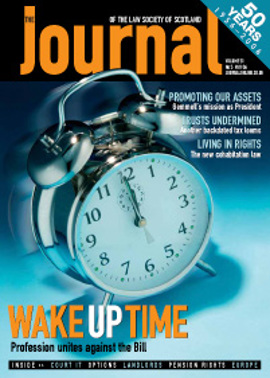Lawyers in the transfer market

Consider for a moment the circumstances of two individuals – Bonnie and Clyde – both of whom are members of a team dedicated to providing legal services to a large client. The client has decided to put their professional services out to tender, a move which ultimately results in a decision to switch law firms. Bonnie has struck up a good rapport with those giving the instructions and has thrived on the type of work she was being given to do, and is therefore deeply disappointed at the loss of the client. Meanwhile, Clyde found the client difficult to please and the work monotonous, so he is secretly somewhat less than sorry to see the business go.
Now consider the reaction from both these individuals if their employment were to transfer automatically to the firm which was successful in the tendering process. At opposite ends on a scale of happiness, you would think.
Clyde is not going to be pleased to hear that this is in fact one of the implications of the new Transfer of Undertakings (Protection of Employment) Regulations 2006 (SI 2006/246) which, in contrast to their 25 year old predecessor, provide for more blanket coverage of service provision changes. The intended outcome of the new provisions is the creation of a level playing field for those tendering for service contracts, with a much clearer presumption in favour of TUPE protections applying not only to straightforward changes of service provider, but also to in-housing and outsourcing exercises.
No distinction
During the consultation period leading up to the new regulations, it had been suggested that “professional business services” should be exempt from the service provision rules. Arguments in favour of an exemption included the fact that professionally qualified employees who are key to providing white collar services, are – by virtue of having highly sought-after skills – less in need of additional legal protection than those providing blue collar services. On the flip side it was recognised that it may be both conceptually and legally problematic to draw a clear distinction between professional business services, and other types of services.
Ultimately, however, the decision has been taken to exclude any such exemption. The transfer of, for example, legal and accountancy services may therefore be subject to the regulations, which now provide for service provision changes to be covered where, before the change, there is an organised grouping of employees whose principal purpose is to carry on the service for the client. For the purposes of the regulations one employee is enough to constitute a “grouping”.
Firms will therefore need to rethink the allocation of work in an effort to avoid losing valued members of staff. Client-specific teams where an individual or group of individuals are dedicated to the client may be lost if the client then decides to transfer their work to another provider. It is of note that it is not necessary for an individual to be solely dedicated to providing advice to one client to be regarded as having the principal purpose of carrying out the client work and therefore covered.
The employee’s options
Of course, Clyde is free to refuse to transfer. He can do this without having to give reasons, but if he does so will find his employment automatically terminated by his current employer – a termination which will not constitute a dismissal and therefore could not found an unfair dismissal claim. Furthermore, he will be treated as having resigned, would have no entitlement to a redundancy payment and his continuity of employment would be broken. Although it would be open to the firm to re-employ him, they could potentially take the opportunity to offer him amended terms and conditions, with little recourse for him should these be less favourable.
Meanwhile, although Bonnie enjoys the work and so on, she is likely to be less than impressed at the thought of a transfer where it may involve a substantial change in working conditions. If Bonnie believes that changes, perhaps a relocation of some distance, is to her “material detriment” she can resign. In such circumstances, Bonnie will be treated as having been dismissed by her employer and will retain her statutory rights, with the exception of a claim for pay in lieu of notice. This new provision means that a transferring employee need not show that their contract has actually been breached before claiming (effectively) constructive dismissal.
The new provisions certainly give much food for thought. The client who has initiated the tendering process because they felt their legal team were underperforming is unlikely to thrilled at the prospect of being saddled with that same team after the process is complete. The process and the risks can be managed by all concerned, but it is now essential that the staff impact is factored into tendering, client gain and retention exercises.
Jane Fraser, Head of Employment, Pensions and Benefits, Maclay Murray & Spens
In this issue
- Stand up to be counted
- A bill to divide us
- The pendulum swings
- The pendulum swings (1)
- Cohabitation: the new legal landscape
- The tax man cometh (again)
- The foreign legion
- Making IT happen
- Apportioning and sharing
- Property problems
- Still a profession
- Arguing over agreements
- Next generation law
- Lawyers in the transfer market
- Scottish Solicitors' Discipline Tribunal
- Landlords: setting the mark
- Website review
- Book reviews
- Purchase options in leases






